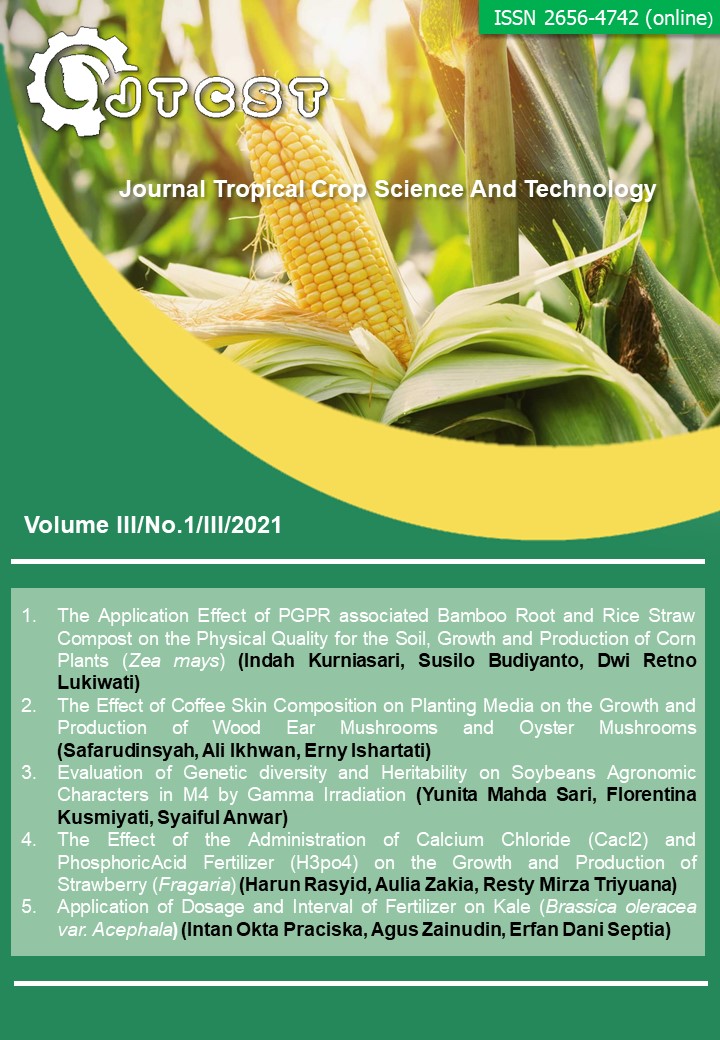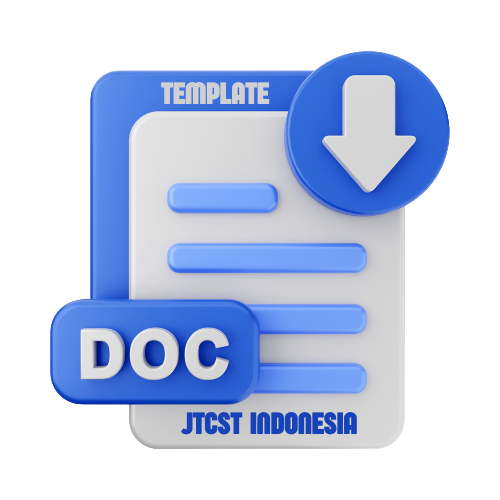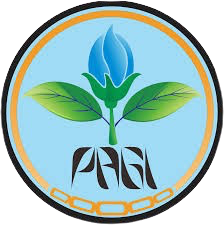The Effect of Coffee Skin Composition on Planting Media on the Growth and Production of Wood Ear Mushrooms and Oyster Mushrooms
DOI:
https://doi.org/10.22219/jtcst.v3i1.29697Keywords:
mushroom, growing medium, coffee skinAbstract
This study evaluated the interaction between mushroom species (ear mushrooms and oyster mushrooms) and growing media (with the addition of coffee peels) on mushroom growth and yield. The results showed that oyster mushrooms were superior to ear mushrooms in various parameters, including mycelial growth, time to first primordia emergence, harvest wet weight, and dry weight. The use of media with the addition of 20% coffee skin showed good results, with significant mushroom growth and yield. This research was conducted at the Production Unit of the Integrated Land Biotechnology Development Center, Faculty of Agriculture and Animal Husbandry, Muhammadiyah University of Malang from November 2019 to January 2020. This research used an experimental method with two types of mushrooms and three different compositions of growing media. The results of data analysis showed significant differences between treatments, with oyster mushrooms showing better results than ear mushrooms. These results can be a guideline for oyster mushroom cultivation by utilizing coffee skin waste as an effective growing medium.
Downloads
References
Aini, F. N., & Kuswytasari, N. D. (2013). Pengaruh Penambahan Eceng Gondok (Eichhornia Crassipes) Terhadap Pertumbuhan Jamur Tiram Putih (Pleurotus Ostreatus). Jurnal sains dan seni pomits, Vol. 2, No.1, Hal. 116-120.
Ansori, A. (2017). Pemanfaatan Serbuk Gergaji Kayu Sengon (Albizia Falcataria) dan Kotoran Kambing Sebagai Bahan Baku Pupuk Organik Cair Dengan Penambahan Effective Microorganism-4 (EM4). Surakarta: Skripsi. Universitas Muhammadiyah Surakarta.
Asegab, M. (2010). Bisnis Pembibitan jamur tiram, jamur merang dan jamur Kuping. Jakarta: PT Agromedia Pustaka.
Cahyana Y.A, Muchroji, M Bachrun (2006). Jamur Tiram.Jakarta. Penebar Swadaya.
Dalimunthe, F. K. (2018). Pertumbuhan dan Produktivitas Jamur Tiram (Pleurotus ostreatus) Pada Media Tanam Campuran Berbeda dan Penambahan Air Cucian Beras. Medan: Skripsi. Universitas Muhammadiyah Sumatera Utara.
DistanJabar. (2020). Cara Mengatasi Penyakit Jamur Tiram yang Kerap Dialami. Diakses pada 5 juni 2022, dari distan/blog/index/3: http://distan.jabarprov.go.id
Ginting, A. R., Herlina, N., & Tyasmoro, S. Y. (2013). Studi Pertumbuhan Dan ProduksiJamur Tiram Putih ( Pleurotus Ostreatus) Pada Media Tumbuh Gergaji Kayu Sengon Dan Bagas Tebu. Jurnal Produksi Tanaman, Vol. 1 No.2. Hlm17-24.
Hadiyanto. (2012). Pengaruh Lingkungan terhadap Pertumbuhan Jamur Tiram (Pleurotus sp.). Makalah Seminar: Politeknik Negeri Lampung.
Harianti. (2014) Pengaruh Penambahan Bahan organik pada Komposisi Meda Tanam F3 Terhadap Pertumbuhan dan Perkembangan Jamur Tiram Abu-abu (Pleurotus Sajor-Caju). Skripsi. UIN Malik Ibrahim Malang
Hartati, S. E., Sudarmonowati, W., Fatriasari, Hermiati, E., Dwianto, w., Kaida, R., et al. (2010). Wood Characteristic of Superior Sengon Collection and Prospect of Wood Properties Improvement through Genetic Engineering. Journal of Indonesia Wood Research, 1(2) : 103-106.
Hidayah, N., Tambaru, E., & Abdullah, A. (2017). Potensi Ampas Tebu Sebagai Media Tanam Jamur Tiram (Pleurotus Sp). Bioma : Jurnal Biologi Makassar, Vol. 2 (2) Hlm 28-38.
Islami, A., Purnomo, A. S., & Suksesi. (2014). Pengaruh Komposisi Ampas Tebu dan Kayu Sengon Sebagai Media Tanam Pertumbuhan Terhadap Nutrisi Jamur Tiram (Pleurotus ostreatus). Jurnal Sains dan Seni Pomits, Vol.2, No. 1.
Kailola, J., Simanjuntak, R., & Punyia, K. (2019). Kandungan Kadar Air (H20) Dari Jenis Kayu Jati (Tectona grandis) dan Kayu Sengon (Paraserianthes falcataria) Asal Tobelo Kabupaten Halmahera Utara. Agrikan, Vol. 11 (2). Hlm. 311-316.
Kenanga, P., Pambudi , A., & Puspitasari, R. L. (2014). Perbandingan Pertumbuhan Jamur Tiram Di Kumbung Ciseang dan Universitas Al-Azhar Indonesia. Al-Kauniyah Jurnal Biologi, vol. 7 (2). Hlm. 94-98.
Konten, B. B., Paga, A., Wea, R., & Tai, S. B. (2015). Pengaruh lama pemeraman dengan nira lontar terhadap perubahan fraksi serat kulit kopi kering. Jurnal Ilmu Ternak, Vol.15. No. 1. Hal.50-55.
Kusumaningrum, D., & Heddy, S. (2018). Pengaruh Komposisi Daun Tebu dan Serbuk Kayu Sengon Sebagai Media Tumbuh Pada Pertumbuhan dan Produksi Jamur Tiram Putih (Pleurotus Florida). Jurnal Produksi Pertanian, Vol. 6. Hlm. 1327-1325.
Laksono, R. (2019). Uji daya hasil jamur tiram putih (Pleurotus ostreatus) akibat aplikasi jenis nutrisi alternatif dengan pendekatan bioklimatik di kabupaten Karawang. Jurnal Kultivasi, Vol. 18 (3) Hlm. 942-951.
Maryati. (2010) Laporan Magang Budidaya Jamur Kuping (Auricularia Auricula Judae(Linn.) Schroter). UPTD. Balai Pengembangan dan Promosi Tanaman Pangan Hortikultura. Surakarta
Maulidina, R., Murdiono, W. E., & Nawawi, M. (2015). Pengaruh Umur Bibit dan Komposisi Media Tanam Terhadap Pertumbuhan dan Hasl Jamur Tiram Putih (Pleurotus ostreatus). Jurnal Produksi Tanaman, Vol. 3. No. 8. Hlm. 649-657.
Nofu, K., Khotimah, S., & Lovadi, I. (2014). Isolasi dan Karakteristik Bakteri Pendegradasi Selulosa Pada Ampas Tebu Kuning (Bagasse). Jurnal Protobiont, Vol 3 (1) Hlm. 25 - 33.
Nurilla, N. L. (2013). Studi Pertumbuhan dan Produksi Jamur Kuping (Auricularia auricula) pada Substrat Serbuk Gergaji Kayu dan Serbuk Sabut Kelapa. Jurnal Produksi Tanaman, Vol 1 (3) : 41-47.
Parjimo, H., & Agus, H. (2010). Budidaya Jamur Kuping. Banda Aceh: Agromedia.
Pertiwi, N. (2016). Kandungan Lignin, Selulosa, Hemiselulosa Dan Tanin Limbah Kulit Kopi Yang Difermentasi Menggunakan Jamur Aspergillus Niger dan Trichoderma Viride. Makassar: Skripsi. Universitas Hasanuddin.
Purnomo, H. (2012) Kajian Penambahan Jerami Padi (Oryza Sativa) pada Komposisi Media Tanam (Baglog) Terhadap Pertumbuhan Jamur Tiram Putih (Pleurotus Ostreatus). Skripsi. UIN Malik Ibrahim Malang.
Rochman, A. (2015). Perbedaan Proporsi Dedak Dalam Media Tanam Terhadap Pertumbuhan Jamur Tiram Putih (Pleurotus florida). Jurnal Agribisnis Fakultas Pertanian Unita, 56-67 Vol. 11 No. 13.
Sartika, Y., Saputera, & Zubaidah, S. (2013). Zubaidah, S., 2013, Peningkatan Pertumbuhan dan Hasil Jamur Tiram (Pleurotus ostreatus) Melalui Variasi Komposisi Media Tanam. Jurnal Agripeat, Vol. 14 No. 2 Hal. 95-102.
Setiyono, Gatot, & Ademarta, R. (2011). Pengaruh Ketebalan dan Komposisi Media Terhadap Pertumbuhan dan Produksi Jamur Merang. Agritrop Jurnal Ilmu-Ilmu Pertanian, Hal. 47-53.
Steviani, S. (2011). Pengaruh Penambahan Molase dalam Berbagai Media pada Jamur Tiram Putih (Pleurotus Ostreatus). Skripsi. Surakarta. Fakultas Pertanian. Universitas Sebelas Maret.
Sugianto, A. (2017). Pengembangan Teknologi Jamur Kayu Sebagai Pangan Alternatif. Malang: Aditya Media Publishing.
Suryani, T., & Carolina, H. (2017). Pertumbuhan dan Hasil Jamur Tiram Putih Pada Beberapa Media Pembibitan. Bioeksperimen, Vol. 3 No.1. Hlm. 73-86.
Utami, S., Umrah, & Suwastika, I. N. (2020). Formulasi Media Produksi Jamur Tiram (Pleurotus ostreatus) Dengan Suplementasi Ampas Sagu. Jurnal Biocelebes, Vol. 14. No. 1. Hlm. 59-69.
Wardhana, D. I., Ruriana, E., & Nafi, A. (2019). Karakteristik Kulit Kopi Robusta Hasil Samping Pengolahan Metode Kering dari Perkebunan Kopi Rakyat di Jawa Timur. Agritrop, Vol. 17 (2): 214-223.
Warisno dan Dahana. (2010). Tiram Menabur Jamur Menuai Rupiah. Jakarta: Gramedia Pustaka Utama.
Downloads
Published
How to Cite
Issue
Section
License
Copyright (c) 2021 Safarudinsyah, Ali Ikhwan, Erny Ishartati

This work is licensed under a Creative Commons Attribution-ShareAlike 4.0 International License.
Authors who publish with this journal agree to the following terms:
- Authors retain copyright and grant the journal right of first publication with the work simultaneously licensed under a Creative Commons Attribution License that allows others to share the work with an acknowledgement of the work's authorship and initial publication in this journal.
- Authors are able to enter into separate, additional contractual arrangements for the non-exclusive distribution of the journal's published version of the work (e.g., post it to an institutional repository or publish it in a book), with an acknowledgement of its initial publication in this journal.
- Authors are permitted and encouraged to post their work online (e.g., in institutional repositories or on their website) prior to and during the submission process, as it can lead to productive exchanges, as well as earlier and greater citation of published work (See The Effect of Open Access).











